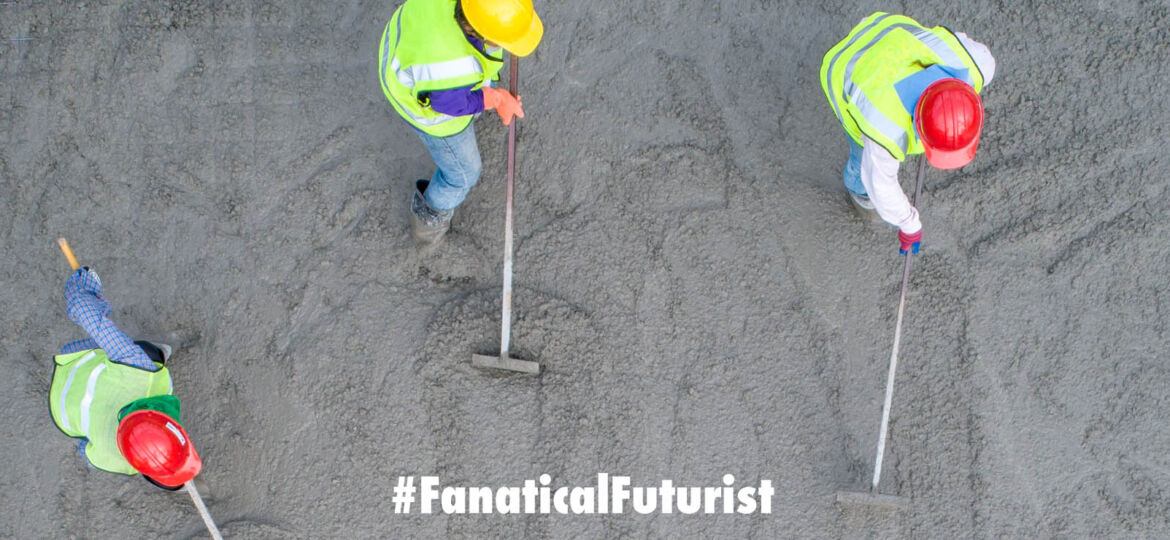
WHY THIS MATTERS IN BRIEF
Carbon negative concrete could not only eliminate 10% of all global greenhouse gas emissions but also reverse them.
 Love the Exponential Future? Join our XPotential Community, subscribe to the podcast, future proof yourself with courses from XPotential University, read about exponential tech and trends, connect, watch a keynote, or browse my blog.
Love the Exponential Future? Join our XPotential Community, subscribe to the podcast, future proof yourself with courses from XPotential University, read about exponential tech and trends, connect, watch a keynote, or browse my blog.
We make more concrete than any other material on the planet, and even though there are now an increasing number of so called Green Concretes on the market, that replace Portland cement with fly ash or even rubber, as well as new Lavacretes used to 3D print buildings. We even have bricks that replicate themselves, and yes the world of fully autonomous green construction is getting odder by the day.
Now though a group of engineers want to make concrete – which accounts for over 7 percent of the world’s annual greenhouse gas emissions – even greener and make it carbon neutral or even carbon negative. And they’ll use microalgae to make it happen.
The team, led by engineers at the University of Colorado, University of North Carolina Wilmington, and the National Renewable Energy Laboratory, has shown it can manufacture biogenic limestone-based Portland cement without the need to quarry the limestone in a carbon-heavy process. Instead, they’re growing it.
“For the industry, now is the time to solve this very wicked problem,” Wil Srubar, an associate professor at the University of Colorado and the lead researcher on the project, says in a news release. “We believe that we have one of the best solutions, if not the best solution, for the cement and concrete industry to address its carbon problem.”
Concrete is everywhere on Earth. To make this key building material, you mix water with Portland cement and create a paste that includes sand, gravel, or crushed stone; from there, the mixture hardens into concrete. To make Portland cement, limestone is extracted from large quarries and burned at high temperatures, releasing large amounts of carbon dioxide.
Concocting a Portland cement mixture that doesn’t need extracted limestone led the research team to biologically grow limestone, a natural process that some species of calcareous microalgae complete through photosynthesis. Think: coral reef formation. The scientists call it a net carbon-neutral way to make Portland cement, as the carbon dioxide released into the atmosphere equals what the microalgae already captured.
The concept of growing limestone came to Srubar while snorkelling in Thailand in 2017. He saw the calcium carbonate, the main component of limestone, grown naturally in the ocean.
“If nature can grow limestone,” he says in the release, “why can’t we?” Continual grants and awards have kept the process moving toward commercialization of microalgae.
Algae naturally uses sunlight, water, and dissolved carbon dioxide to produce the largest amounts of new calcium carbonate, the primary material in limestone. Some ocean-based coccolithophore blooms grow so large they can be seen from space.
“On the surface, they create these very intricate, beautiful calcium carbonate shells,” Srubar says in the release. “It’s basically an armour of limestone that surrounds the cells.”
The team says that if all cement-based construction around the world was replaced with biogenic limestone cement, which behaves the same way as quarried limestone, we could cut back on the 2 gigatons of carbon dioxide annually pumped into the atmosphere as a result of the cement production process, all while pulling more than 250 million additional tons of carbon dioxide out of the atmosphere and into the concrete for permanent storage.
The team believes it needs less than 2 million acres of open ponds to produce all the cement the United States needs – 1 percent of the land used to grow corn. Plus, the cloud-white microalgae is hardy enough to live almost anywhere in the world. The researchers are also working on algae growth optimization and the startup Minus Materials, born from the research, has already made small quantities of the material available with plans to expand.
“We see a world in which using concrete as we know it is a mechanism to heal the planet,” Srubar says. “We have the tools and the technology to do this today.”
















